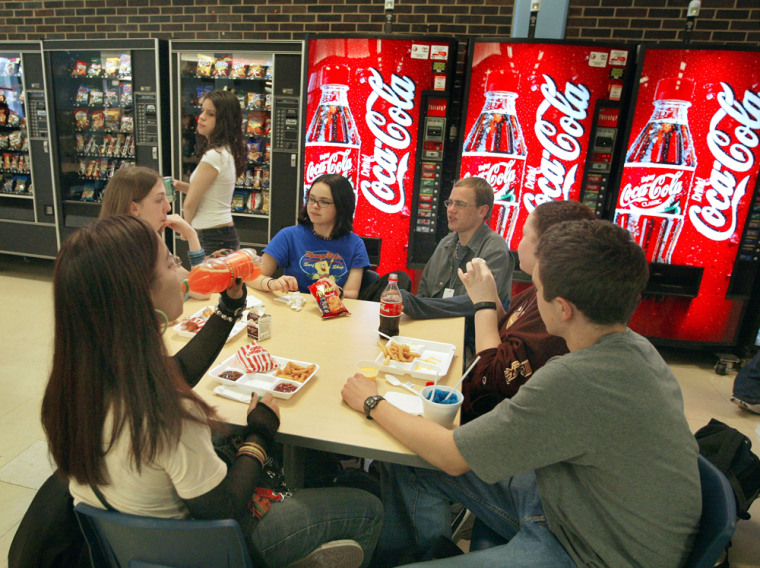After getting hit by a wave of regulation in recent years by school boards and legislators, soft drink makers say they get the message: School isn’t the right place for sugary sodas.
Long the target of people who blame soda’s calories and popularity among young people for contributing to rising childhood obesity, the nation’s largest beverage distributors say they will stop selling non-diet sodas to schools and start serving reduced sizes of other drinks.
“This one policy can add years and years and years to the lives of a very large number of young people,” said former President Bill Clinton, whose foundation announced the deal Wednesday and has targeted childhood obesity for the past year.
The beverage companies agreed to sell only water, unsweetened juice and low-fat and non-fat milk, flavored and unflavored, in elementary and middle schools. Diet sodas and sports drinks will be sold in high schools.
“I don’t think anyone should underestimate the influence this agreement will have,” said Susan Neely, president and CEO of the American Beverage Association. “I think other people are going to want to follow this agreement because it just makes sense.”
The deal was brokered by the Alliance for a Healthier Generation, a collaboration between the William J. Clinton Presidential Foundation and the American Heart Association, and involves industry leaders Cadbury Schweppes PLC, Coca-Cola Co. and PepsiCo Inc. as well as the beverage association, which together control 87 percent of the public and private school drink market. Officials said they hoped the other 13 percent would follow suit.
Beverage industry officials said the agreement is not an admission that their products are unhealthy.
“This is about where we sell our products, not about the products themselves,” Dawn Hudson, CEO of Pepsico for North America, said at the news conference in Clinton’s Manhattan office. “We believe that all our products have a place in a well-balanced diet and proper, active lifestyle.”
Soft drink critics applauded the move but said it does not go far enough.
Richard Daynard, a law professor at Northeastern University, said he had been negotiating a similar deal on behalf of the Public Health Advocacy Institute, which together with the Center for Science in the Public Interest had been preparing to sue beverage makers if no deal had been reached.
“What they agreed to was very close to the final negotiation position we gave them at the end of March,” Daynard said.
Daynard said the deal should not have allowed sports drinks to be sold in high schools. He said the drinks are useful for high-performance athletes but are “simply sugar water” for students.
Ann Cooper, an advocate for healthy school lunches who directs the food program for public schools in Berkeley, Calif., called the deal a good first step.
“Any agreement that limits high-fructose corn syrup and sugar and non-nutrient foods that are served in schools is good, but I don’t think it goes far enough,” she said, citing the calorie content of sports drinks and some flavored milks.
Daynard said the 10 largest cities have already banned soda sales in schools in recent years. Still, the deal imposes stricter drink regulations than are currently in place for nearly 35 million public school students.
Anne Bryant, executive director of the National School Boards Association, said she welcomed the agreement.
“We’re pleased that the parties have decided that there is no need for litigation, because litigation is a terrible waste of time and money,” she said.
John Sicher, editor and publisher of Beverage Digest, which compiles extensive data on the beverage industry, said the agreement would have no impact on the $63 billion beverage industry’s bottom line.
“The sale of sugar-carbonated sodas in schools is a tiny, tiny part of their overall volume,” said Sicher. “Financially, on the big companies, it will have virtually no impact.”
He applauded the move, however. “The impact is more in terms of responsibility and accountability to the consumer,” he said.
Under the agreement, high schools will still be able to sell low-calorie drinks that contain less than 10 calories per serving, as well as up to 12-ounce servings of juice, sports drinks and low-fat and nonfat milk.
The serving sizes for juice and milk will shrink to 10 ounces for middle school students and 8 ounces for elementary school students. Diet sodas and sports drinks won’t be sold in middle and elementary schools, and full-sugar soda and whole milk will no longer be offered.
School sales of sports drinks, diet sodas and bottled water have been on the rise in recent years, while sugary soft drink purchases by students have been falling, according to an ABA report released in December. But regular soda, averaging 150 calories a can, is still the most popular drink, accounting for 45 percent of drinks sold in schools in 2005, according to the report.
The new rules will apply to beverages sold on school grounds during the regular school day and at after-school activities such as band and choir practice. Soda sales at events such as school plays, band concerts and sporting events, where adults are a significant portion of the audience, won’t be affected.
The companies will work to implement the changes at 75 percent of public and private schools they have contracts with before the 2008-2009 school year, and at all of the schools a year later.
The agreement follows an August decision by the ABA to adopt a policy limiting soft drinks in high schools to no more than 50 percent of the selections in vending machines. Unlike the agreement announced Wednesday, that recommendation was not binding.
Most elementary schools are already soda-free.
